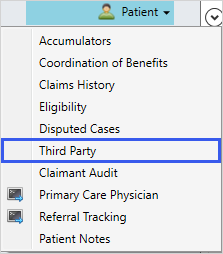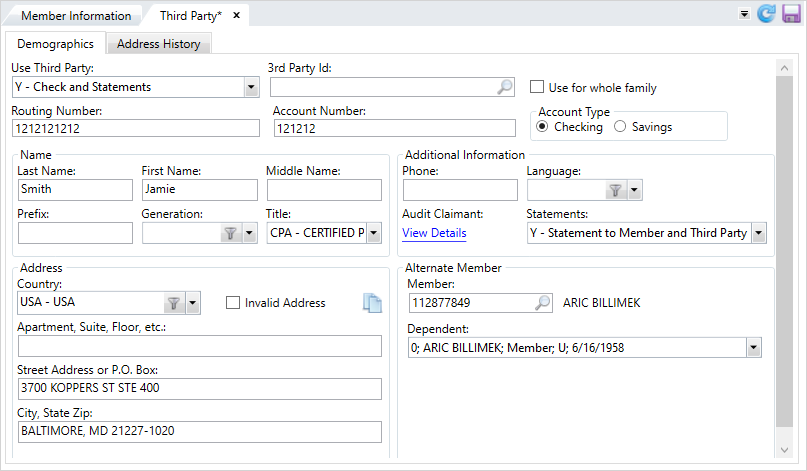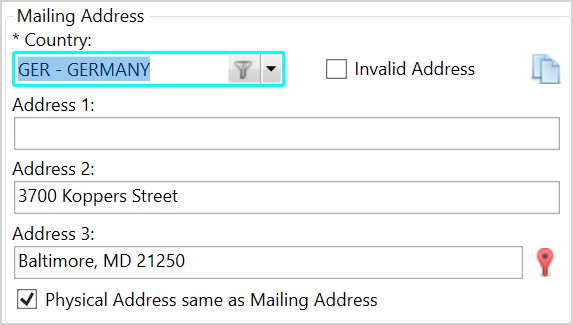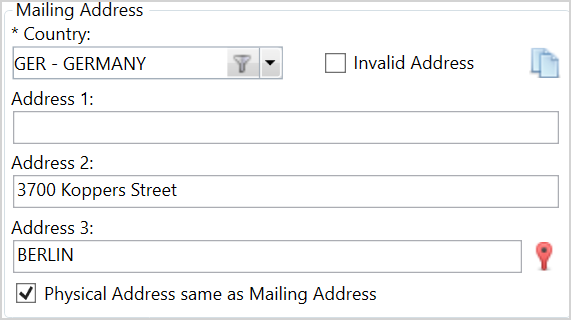A third party is setup when a payment needs to be sent to someone other than the provider or member. Direct deposit bank deposits can be made to the member using a third party ID number.
Access Third Party
There are a few ways to view and enter Third Party information from a member, dependent, or claim:
- Search for and open a member or dependent.
- Select
Claims, and then selectThird Party.

OR
- Search for and open a claim.
- Select
Patient, and then selectThird Party.

Enter information

-
Enter data into the
Demographicstab. Demographics Field Descriptions
Demographics Field Descriptions
Column Description Use Third Party Determines if the Third Party address is used for claims assigned to the member.
Y—Checks and Statements.N—No third party.C—Checks only.S—Statements only.
Unique Third Party ID number. This helps you identify the Third Party when batch checks are issued to the same Third Party for multiple members. If an ID number is used, the address, phone, and language for the Third Party updates and are read-only. This is useful if multiple claimants use the same third party.
Use for whole family
Check box that indicates the third party address is used for all dependents.
Nine-digit code based on the US. Bank location where the Member's account was opened.
It's the first set of numbers printed on the bottom left of a check. You must enter a value or you can't save the Third Party Account Number or the Account Type.
Account Number Member's account number. Used when batch checks are issued to a Third Party. You can only save this value if you select a Routing Number.
Account Type
Either
CheckingorSavingsaccount.Name Last Name The individual's last name. First Name
The individual's first name.
Middle Name The individual's middle name. Prefix A title that displays at the beginning of a person's name to indicate marital status and gender, education, or occupation, (e.g., Dr., Mrs., PhD, etc.) Generation Suffix to distinguish persons that share the same name in a family, (e.g. Jr., II, Sr, etc.) Title A professional or some other designation that comes at the end of a name, for example, CPA, MD, ESQ, etc. Address Country Country of the Third Party.
When entering an address for a country outside of the United States, a country code selection icon displays if you've configured the
Possibilities for Address Line 3table on theCountry Codesscreen (see Manage Country Codes).For example, after selecting Germany as the Country for the mailing address,
 displays. The lines for the American address format (Apartment/Suite/Floor, Street Address or P.O. Box, and City, State, and Zip) also change to Address Line 1, 2, and 3.
displays. The lines for the American address format (Apartment/Suite/Floor, Street Address or P.O. Box, and City, State, and Zip) also change to Address Line 1, 2, and 3.
Select
 to view a list of address 3 options for the country entered. This example displays options for Germany.
to view a list of address 3 options for the country entered. This example displays options for Germany.
You can choose an option from this window to be the address line 3 information and click
 , or manually enter the address line 3 if needed or preferred.
, or manually enter the address line 3 if needed or preferred. Note:
Note: doesn't display if you haven't configured options for the
doesn't display if you haven't configured options for the Possibilities for Address Line 3table on theCountry Codesscreen. Contact your administrator for more information.Invalid Address Invalid Address- Check box indicating the address isn't valid.Address 1 The apartment, suite, floor, etc. This is the first line in the address that isn't a street address or PO box number.
Address 2 The street address or PO box information. Address 3 The city, state, and ZIP code.
Additional Information Phone The individual's phone number. Language The individual's preferred language. Audit Claimant Select the
View Detailslink to display the Claimant Audit screen.Statements Indicates if an Explanation Of Benefits (EOB
 EOBs are sent to members and payees to inform them of the disposition of claims. Typically an EOB identifies the date and type of service, the billed amount, deductibles, co-insurance, and an explanation of any ineligible charges. An EOB can also be a helpful tool in identifying fraudulent claims, as the member receives notification even when payment is made to the provider. An EOB isn't a bill.) statement should be sent to the member when a payment or an EOB
EOBs are sent to members and payees to inform them of the disposition of claims. Typically an EOB identifies the date and type of service, the billed amount, deductibles, co-insurance, and an explanation of any ineligible charges. An EOB can also be a helpful tool in identifying fraudulent claims, as the member receives notification even when payment is made to the provider. An EOB isn't a bill.) statement should be sent to the member when a payment or an EOB EOBs are sent to members and payees to inform them of the disposition of claims. Typically an EOB identifies the date and type of service, the billed amount, deductibles, co-insurance, and an explanation of any ineligible charges. An EOB can also be a helpful tool in identifying fraudulent claims, as the member receives notification even when payment is made to the provider. An EOB isn't a bill. is sent to a third party.
EOBs are sent to members and payees to inform them of the disposition of claims. Typically an EOB identifies the date and type of service, the billed amount, deductibles, co-insurance, and an explanation of any ineligible charges. An EOB can also be a helpful tool in identifying fraudulent claims, as the member receives notification even when payment is made to the provider. An EOB isn't a bill. is sent to a third party.N—No Statement to Member.Y—Statement to Member and Third Party.
Alternate Member Member Alternate member number—Identifies the original member's social security number for a dependent who originally existed under another membership number.
This allows for accurate linking of illness, admission, and disputed case data in addition to duplicate checking. This is also the link to accumulators stored under this alternate member or dependent. Note that you can't enter a member number of someone in the member's family, for example, a dependent.
Dependent Dependent's sequence number under the original membership—This field is only available and required when you've entered a value in the Alternate Member field. -
Enter data into the
Address Historytab.
 Address History Field Descriptions
Address History Field Descriptions
- Click
 to save.
to save.